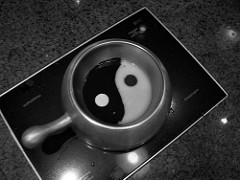I distinctly remember being taught the concept of the melting pot in third grade. The illustration had cartoon people hanging off the edges of a large stewpot into the water, apparently so caught up in the spirit of bonhomie that they didn’t realize they had become food. I drew a Pac-Man in the book as the chef.
 Even then the idea of an American melting pot was on the way out. The overtones of assimilation were too strong, even in the analogy. Add cream to tomato soup, and you have creamy tomato soup, but tomato soup nonetheless. The homogeneous nature of the model is the problem. The dominant quality of the thing prevails and subsumes the subordinate.
Even then the idea of an American melting pot was on the way out. The overtones of assimilation were too strong, even in the analogy. Add cream to tomato soup, and you have creamy tomato soup, but tomato soup nonetheless. The homogeneous nature of the model is the problem. The dominant quality of the thing prevails and subsumes the subordinate.
Sinoangle at Resist Racism rails against the anti-Christmas movement done in the name of “inclusion”. They have a good point – but it’s the same problem as the “melting pot”, just approached from the other side. Instead of a homogeneous dominant flavor of soup, we’ll instead have a pot of hot water.
Instead, we should strive for stew. (Yum. Stew.) Stew has a lot of ingredients. They all influence each other, but each ingredient (meat, potatoes, green beans, etc) retains a good portion of its original characteristics. Additionally, they all work together to make the flavor of the dish.
 Looking at the winter holidays as a stew means that there are non-religious christmas celebrations and religious Christmas ones, that there is room for Eid and Bodhi day and Chaunakah and Kwanzaa and all the rest. That there is room for secular solstice celebrations and neo-pagan Yules and Saturnalias.
Looking at the winter holidays as a stew means that there are non-religious christmas celebrations and religious Christmas ones, that there is room for Eid and Bodhi day and Chaunakah and Kwanzaa and all the rest. That there is room for secular solstice celebrations and neo-pagan Yules and Saturnalias.
Christmas is a perfect holiday for this to happen with. So many of the associated images and traditions of the holiday are not Christian in origin – though they can be Christian in intent. It has been influenced by other faiths and practices while not losing its essential character. We can easily make room for our brothers and sisters of all faiths and paths to celebrate however they choose, without giving up our own celebrations.
Whatever they might be.
